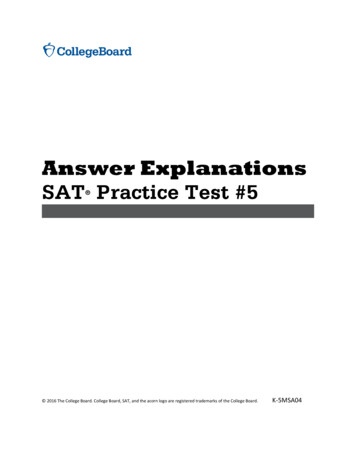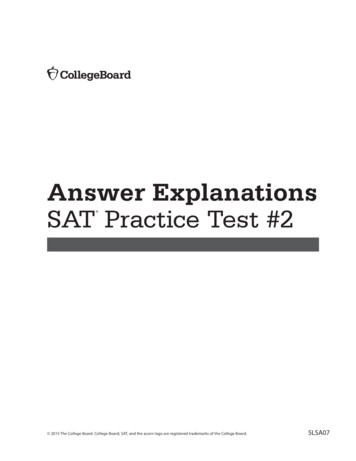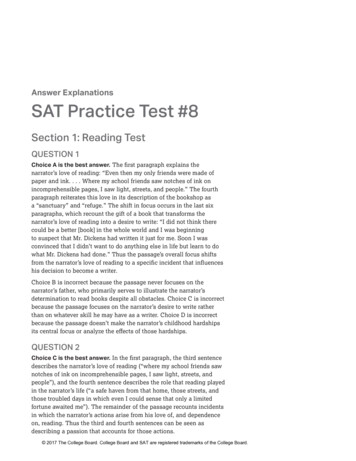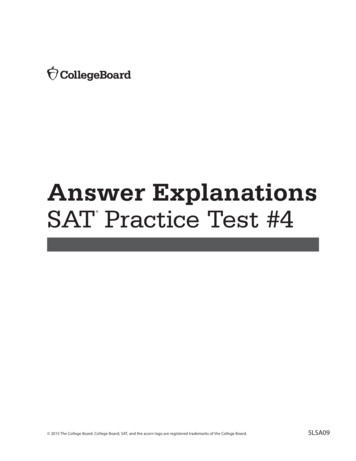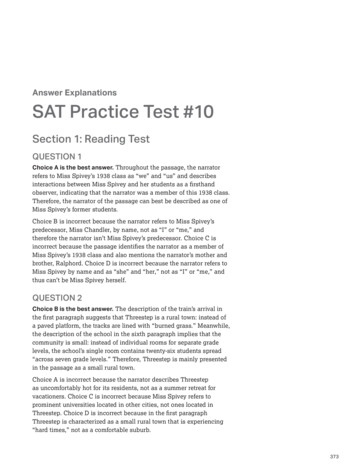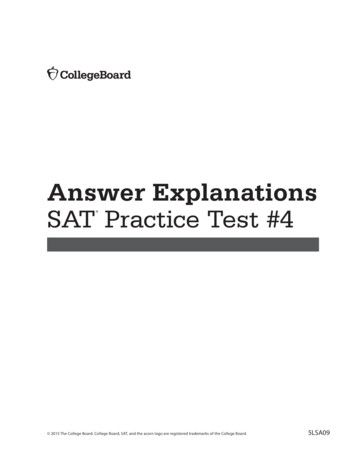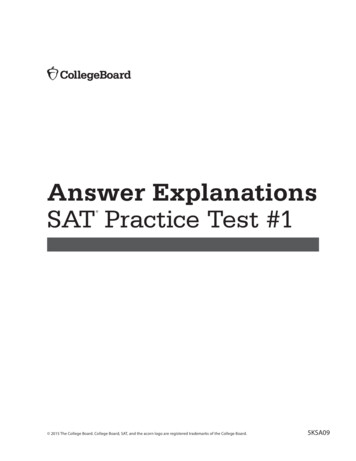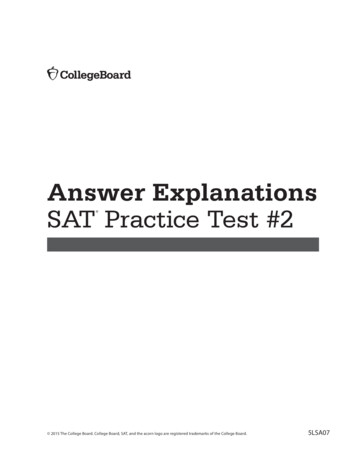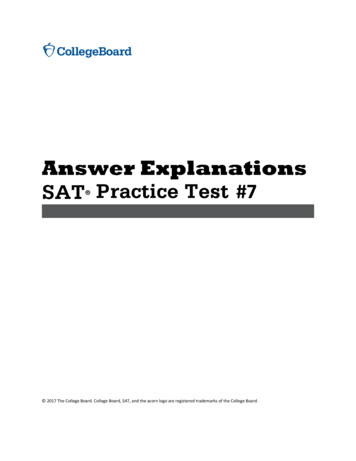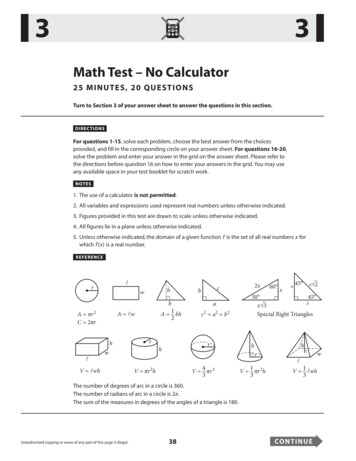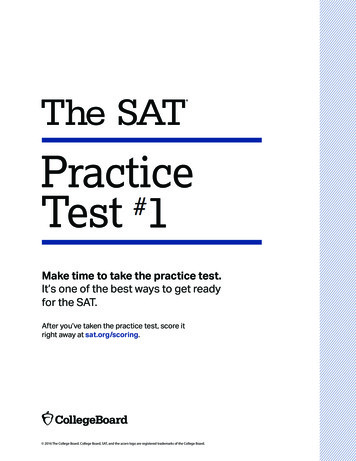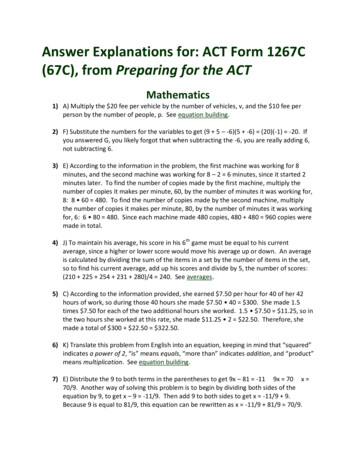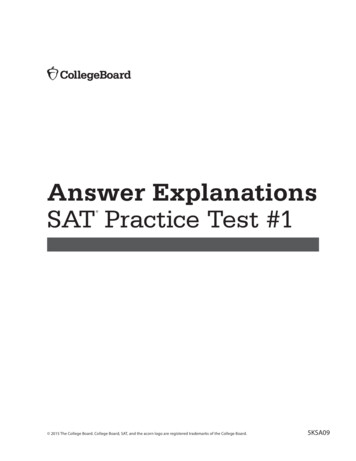
Transcription
Answer ExplanationsSAT Practice Test #1 2015 The College Board. College Board, SAT, and the acorn logo are registered trademarks of the College Board.5KSA09
Answer ExplanationsSAT Practice Test #1Section 1: Reading TestQUESTION 1.Choice B is the best answer. In the passage, a young man (Akira) asks amother (Chie) for permission to marry her daughter (Naomi). The requestwas certainly surprising to the mother, as can be seen from line 47, whichstates that prior to Akira’s question Chie “had no idea” the request was coming.Choice A is incorrect because the passage depicts two characters engagedin a civil conversation, with Chie being impressed with Akira’s “sincerity”and finding herself “starting to like him.” Choice C is incorrect becausethe passage is focused on the idea of Akira’s and Naomi’s present lives andpossible futures. Choice D is incorrect because the interactions betweenChie and Akira are polite, not critical; for example, Chie views Akira with“amusement,” not animosity.QUESTION 2.Choice B is the best answer. The passage centers on a night when a youngman tries to get approval to marry a woman’s daughter. The passage includesdetailed descriptions of setting (a “winter’s eve” and a “cold rain,” lines 5-6);character (Akira’s “soft, refined” voice, line 33; Akira’s eyes “sh[ining] withsincerity,” line 35); and plot (“Naomi was silent. She stood a full half minutelooking straight into Chie’s eyes. Finally, she spoke,” lines 88-89).Choice A is incorrect because the passage focuses on a nontraditional marriage proposal. Choice C is incorrect because the passage concludes withoutresolution to the question of whether Akira and Naomi will receive permission to marry. Choice D is incorrect because the passage repeatedly makesclear that for Chie, her encounter with Akira is momentous and unsettling,as when Akira acknowledges in line 73 that he has “startled” her.1
QUESTION 3.Choice C is the best answer. Akira “came directly, breaking all tradition,”(line 1) when he approached Chie and asked to marry her daughter, and he“ask[ed] directly,” without “a go-between” (line 65) or “mediation,” becausedoing otherwise would have taken too much time.Choices A, B, and D are incorrect because in these contexts, “directly” doesnot mean in a frank, confident, or precise manner.QUESTION 4.Choice A is the best answer. Akira is very concerned Chie will find his mar-riage proposal inappropriate because he did not follow traditional protocol anduse a “go-between” (line 65). This is clear in lines 63-64, when Akira says toChie “Please don’t judge my candidacy by the unseemliness of this proposal.”Choice B is incorrect because there is no evidence in the passage that Akiraworries that Chie will mistake his earnestness for immaturity. Choice C is incorrect because while Akira recognizes that his unscheduled visit is a nuisance, hislarger concern is that Chie will reject him due to the inappropriateness of hisproposal. Choice D is incorrect because there is no evidence in the passage thatAkira worries Chie will underestimate the sincerity of his emotions.QUESTION 5.Choice C is the best answer. In lines 63-64, Akira says to Chie, “Pleasedon’t judge my candidacy by the unseemliness of this proposal.” This revealsAkira’s concern that Chie may say no to the proposal simply because Akiradid not follow traditional practices.Choices A, B, and D do not provide the best evidence for the answer to theprevious question. Choice A is incorrect because line 33 merely describesAkira’s voice as “soft, refined.” Choice B is incorrect because lines 49-51reflect Chie’s perspective, not Akira’s. Choice D is incorrect because lines71-72 indicate only that Akira was speaking in an eager and forthright matter.QUESTION 6.Choice D is the best answer because Akira clearly treats Chie with respect,including “bow[ing]” (line 26) to her, calling her “Madame” (line 31), andlooking at her with “a deferential peek” (line 34). Akira does not offer Chieutter deference, though, as he asks to marry Naomi after he concedes that heis not following protocol and admits to being a “disruption” (line 31).Choice A is incorrect because while Akira conveys respect to Chie, there isno evidence in the passage that he feels affection for her. Choice B is incorrect because neither objectivity nor impartiality accurately describes howAkira addresses Chie. Choice C is incorrect because Akira conveys respectto Chie and takes the conversation seriously.2
QUESTION 7.Choice D is the best answer. The first paragraph (lines 1-4) reflects on howAkira approached Chie to ask for her daughter’s hand in marriage. In theselines, the narrator is wondering whether Chie would have been more likelyto say yes to Akira’s proposal if Akira had followed tradition: “Akira camedirectly, breaking all tradition. Was that it? Had he followed form—had heasked his mother to speak to his father to approach a go-between—wouldChie have been more receptive?” Thus, the main purpose of the first paragraph is to examine why Chie reacted a certain way to Akira’s proposal.Choice A is incorrect because the first paragraph describes only one aspect ofJapanese culture (marriage proposals) but not the culture as a whole. Choice Bis incorrect because the first paragraph implies a criticism of Akira’s individualmarriage proposal but not the entire tradition of Japanese marriage proposals.Choice C is incorrect because the narrator does not question a suggestion.QUESTION 8.Choice B is the best answer. In line 1, the narrator suggests that Akira’sdirect approach broke “all tradition.” The narrator then wonders if Akira had“followed form,” or the tradition expected of him, would Chie have beenmore receptive to his proposal. In this context, following “form” thus meansfollowing a certain tradition or custom.Choices A, C, and D are incorrect because in this context “form” does notmean the way something looks (appearance), the way it is built (structure),or its essence (nature).QUESTION 9.Choice C is the best answer. Akira states that his unexpected meeting withChie occurred only because of a “matter of urgency,” which he explains as “anopportunity to go to America, as dentist for Seattle’s Japanese community”(lines 41-42). Akira decides to directly speak to Chie because Chie’s responseto his marriage proposal affects whether Akira accepts the job offer.Choice A is incorrect because there is no evidence in the passage that Akira isworried his parents will not approve of Naomi. Choice B is incorrect becauseAkira has “an understanding” with Naomi (line 63). Choice D is incorrect;while Akira may know that Chie is unaware of his feelings for Naomi, this isnot what he is referring to when he mentions “a matter of urgency.”QUESTION 10.Choice B is the best answer. In lines 39-42, Akira clarifies that the “mat-ter of urgency” is that he has “an opportunity to go to America, as dentistfor Seattle’s Japanese community.” Akira needs Chie’s answer to his marriageproposal so he can decide whether to accept the job in Seattle.3
Choices A, C, and D do not provide the best evidence for the answer to theprevious question. Choice A is incorrect because in line 39 Akira apologizesfor interrupting Chie’s quiet evening. Choice C is incorrect because lines58-59 address the seriousness of Akira’s request, not its urgency. Choice Dis incorrect because line 73 shows only that Akira’s proposal has “startled”Chie and does not explain why his request is time-sensitive.QUESTION 11.Choice A is the best answer. Lines 1-9 include examples of how manypeople shop (“millions of shoppers”), how much money they spend (“over 30 billion at retail stores in the month of December alone”), and the manyoccasions that lead to shopping for gifts (“including weddings, birthdays,anniversaries, graduations, and baby showers.”). Combined, these examplesshow how frequently people in the US shop for gifts.Choice B is incorrect because even though the authors mention that“ 30 billion” had been spent in retail stores in one month, that figure isnever discussed as an increase (or a decrease). Choice C is incorrect becauselines 1-9 provide a context for the amount of shopping that occurs in the US,but the anxiety (or “dread”) it might cause is not introduced until later in thepassage. Choice D is incorrect because lines 1-9 do more than highlight thenumber of different occasions that lead to gift-giving.QUESTION 12.Choice B is the best answer. Lines 9-10 state “This frequent experienceof gift-giving can engender ambivalent feelings in gift-givers.” In the subsequent sentences, those “ambivalent” feelings are further exemplified asconflicted feelings, as shopping is said to be something that “[m]any relish”(lines 10-11) and “many dread” (line 14).Choices A, C, and D are incorrect because in this context, “ambivalent” doesnot mean feelings that are unrealistic, apprehensive, or supportive.QUESTION 13.Choice D is the best answer. In lines 10-13, the authors clearly state thatsome people believe gift-giving can help a relationship because it “offers apowerful means to build stronger bonds with one’s closest peers.”Choice A is incorrect because even though the authors state that someshoppers make their choices based on “egocentrism,” (line 33) there isno evidence in the passage that people view shopping as a form of selfexpression. Choice B is incorrect because the passage implies that shoppingis an expensive habit. Choice C is incorrect because the passage states thatmost people have purchased and received gifts, but it never implies that people are required to reciprocate the gift-giving process.4
QUESTION 14.Choice A is the best answer. In lines 10-13, the authors suggest that peoplevalue gift-giving because it may strengthen their relationships with others:“Many relish the opportunity to buy presents because gift-giving offers apowerful means to build stronger bonds with one’s closest peers.”Choices B, C, and D do not provide the best evidence for the answer to theprevious question. Choice B is incorrect because lines 22-23 discuss howpeople often buy gifts that the recipients would not purchase. Choice C isincorrect because lines 31-32 explain how gift-givers often fail to considerthe recipients’ preferences. Choice D is incorrect because lines 44-47 suggestthat the cost of a gift may not correlate to a recipient’s appreciation of it.QUESTION 15.Choice A is the best answer. The “deadweight loss” mentioned in the secondparagraph is the significant monetary difference between what a gift-giverwould pay for something and what a gift-recipient would pay for the sameitem. That difference would be predictable to social psychologists, whoseresearch “has found that people often struggle to take account of others’perspectives—their insights are subject to egocentrism, social projection,and multiple attribution errors” (lines 31-34).Choices B, C, and D are all incorrect because lines 31-34 make clear thatsocial psychologists would expect a disconnect between gift-givers and giftrecipients, not that they would question it, be disturbed by it, or find it surprising or unprecedented.QUESTION 16.Choice C is the best answer. Lines 41-44 suggest that gift-givers assumea correlation between the cost of a gift and how well-received it will be:“. . . gift-givers equate how much they spend with how much recipients willappreciate the gift (the more expensive the gift, the stronger a gift-recipient’sfeelings of appreciation).” However, the authors suggest this assumption maybe incorrect or “unfounded” (line 47), as gift-recipients “may not construesmaller and larger gifts as representing smaller and larger signals of thoughtfulness and consideration” (lines 63-65).Choices A, B, and D are all incorrect because the passage neither statesnor implies that the gift-givers’ assumption is insincere, unreasonable, orsubstantiated.QUESTION 17.Choice C is the best answer. Lines 63-65 suggest that the assumption madeby gift-givers in lines 41-44 may be incorrect. The gift-givers assume thatrecipients will have a greater appreciation for costly gifts than for less costly5
gifts, but the authors suggest this relationship may be incorrect, as giftrecipients “may not construe smaller and larger gifts as representing smallerand larger signals of thoughtfulness and consideration” (lines 63-65).Choices A and D are incorrect because lines 53-55 and 75-78 address thequestion of “why” gift-givers make specific assumptions rather than addressing the validity of these assumptions. Choice B is incorrect because lines55-60 focus on the reasons people give gifts to others.QUESTION 18.Choice D is the best answer. Lines 53-55 state that “Perhaps givers believethat bigger (i.e., more expensive) gifts convey stronger signals of thoughtfulness and consideration.” In this context, saying that more expensive gifts“convey” stronger signals means the gifts send, or communicate, strongersignals to the recipients.Choices A, B, and C are incorrect because in this context, to “convey” something does not mean to transport it (physically move something), counteract it (act in opposition to something), or exchange it (trade one thingfor another).QUESTION 19.Choice A is the best answer. The paragraph examines how gift-giversbelieve expensive gifts are more thoughtful than less expensive gifts andwill be more valued by recipients. The work of Camerer and others offersan explanation for the gift-givers’ reasoning: “gift-givers attempt to signaltheir positive attitudes toward the intended recipient and their willingness toinvest resources in a future relationship” (lines 57-60).Choices B, C, and D are incorrect because the theory articulated by Camererand others is used to explain an idea put forward by the authors (“giversbelieve that bigger . . . gifts convey stronger signals”), not to introduce anargument, question a motive, or support a conclusion.QUESTION 20.Choice B is the best answer. The graph clearly shows that gift-givers believeth
SAT Practice Test #1 Section 1: Reading Test QUESTION 1. Choice B is the best answer. In the passage, a young man (Akira) asks a mother (Chie) for permission to marry her daughter (Naomi). The request was certainly surprising to the mother, as can be seen from line 47, which states that prior to Akira’s question Chie “had no idea” the request was coming. Choice A is incorrect because the .File Size: 368KBPage Count: 45
